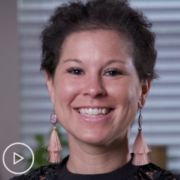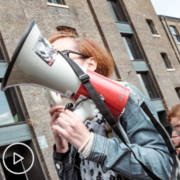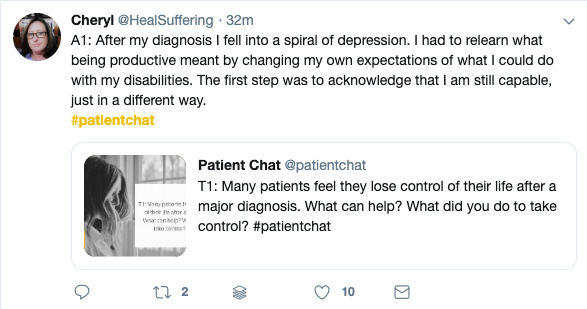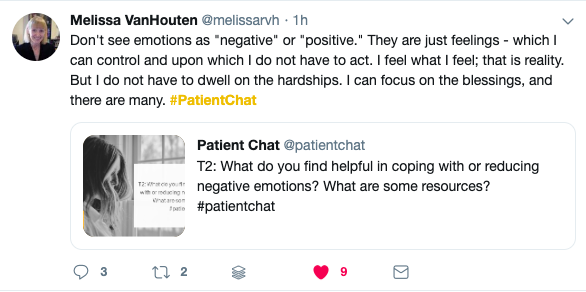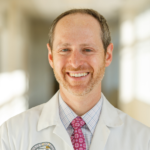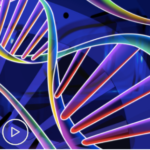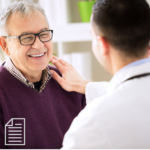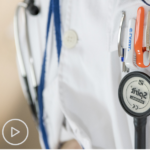AML expert, Dr. Jessica Altman, debunks common AML treatment and side effect myths and shares tips for identifying credible resources and information. Download the accompanying resource guide HERE.
Dr. Jessica Altman is Director of the Acute Leukemia Program at Robert H. Lurie Comprehensive Cancer Center of Northwestern University.
See More From The Fact or Fiction? AML Series
Related Resources
Transcript:
Patricia:
Hi. Welcome to Fact or Fiction: AML Treatment and Side Effects. First, thanks to our partners – the Leukemia and Lymphoma Society and the Aplastic Anemia and MDS International Foundation.
On today’s program, we’ll debunk some common misconceptions about AML treatment and side effects. I am your host, Patricia Murphy. Joining me today is Dr. Jessica Altman. Dr. Altman, get us started by introducing yourself. Tell us a little bit.
Dr. Altman:
Hi. First of all, I want to thank you all for being here and joining us, and it’s an absolute pleasure for me to be here with you. My name is Jessica Altman. I direct the Acute Leukemia program at Northwestern University in Chicago, Illinois.
Patricia:
Thanks so much, Dr. Altman. And just a reminder to our viewers and listeners, this program is not a substitute for medical advice so please refer to your healthcare team.
Dr. Altman, let’s talk a little bit right now about treatments that are currently available for AML. What kinds of things might patients want to familiarize themselves with?
Dr. Altman:
So, we are at a point in AML therapy where there’s not just one choice of treatment.
There are a number of choices that depend on patient characteristics, disease characteristics, and patient goals. So, there’s a lot that the physician with their patient and family members take into account and consider when they’re coming up with a therapeutic strategy.
Patricia:
So, give us a couple of examples. Chemotherapy is one way to treat AML, correct?
Dr. Altman:
Correct. So, the treatments all stem from a chemotherapy backbone. And there are more intensive chemotherapy regimens that usually involve a long, in-patient hospitalization and less intensive chemotherapy regimens. Those chemotherapy regimens can sometimes be combined with targeted therapy based on the genomic structure or the mutations present in leukemia cells.
Patricia:
Stem cell transplant is also an option as well?
Dr. Altman:
Stem cell transplant is an option that is utilized ideally after the leukemia is in remission as a way of maintaining disease control.
And for some patients, that is the best approach for a curative option, and some patients’ leukemia does not require a stem cell transplant.
Patricia:
Clinical trials available as well for AML, doctor?
Dr. Altman:
So, we feel very strongly that the best treatment strategy for most patients is a well-designed, appropriate clinical trial for all phases of AML therapy. It’s because of research and clinical trials over the last number of years that we have had advances and more approvals for the treatments of Acute Myeloid Leukemia.
Patricia:
So, when you’re talking with your patients, what kind of things are you considering when determining how to best treat AML?
Dr. Altman:
So, that’s a great question. This is something that is the basis for the entire conversation that I have with my patients and their family members.
I consider patient goals and patient fitness, other medical conditions, and a lot about the biology of the leukemia. If someone has an acute leukemia that is expected to be highly sensitive to intensive chemotherapy, then that is something that we want to think about. Versus if the patient has a disease that is not expected to be as sensitive to intensive chemotherapy, we frequently like to consider other alternatives in that space.
Patricia:
So, in terms of options, as a patient what kind of things should I be thinking about when I’m working with you as my doctor about what the best treatment for me might be going forward?
Dr. Altman:
So, I think the goal of the initial meetings and the initial consultation between a patient and their healthcare provider is to explore those things. We take a detailed history, understanding patients’ other medical issues. In addition to that, the social history and patients’ goals are very important, as things are not always a yes or no.
They’re not dichotomous choices. And to be able to understand a patient’s goals, and for the healthcare provider to be able to explain what the intent of treatment is helps both parties come to the right decision for that individual patient.
Patricia:
Can you talk a little bit about targeted therapy?
Dr. Altman:
Absolutely. So, targeted therapy – while meant to be specific, because a target is meant to be specific – targeted therapy has become a relatively broad characterization of additional treatments. We think about targeted therapy as the addition of agents that specifically inhibit or target an abnormality associated with the leukemia. The most prominent targeted therapies right now involve specific mutations seen in Acute Myeloid Leukemia.
For instance, about 30% of adults who have newly diagnosed AML will have a mutation in something called FLT3, or F-L-T-3. There is now an approved drug that is combined with standard intensive induction chemotherapy that improves the response rate and overall survival in adults with AML with a FLT3 mutation. In addition, there is now an approved agent for relapsed and refractory FLT3 mutating leukemia.
Patricia:
What about molecular testing? What can you say about that?
Dr. Altman:
So, molecular testing is part of the workup for an adult or a child when they’re newly diagnosed Acute Myeloid Leukemia. And molecular abnormalities look for specific known mutations that occur in Acute Myeloid Leukemia cells.
[00:07:01]
For instance, that FLT3 that I mentioned. In addition, the IDH mutation. Looking for those mutations has always been important in understanding the prognosis, but it’s now especially important because some specific mutations, we have additional therapies that we can give as part of initial treatment or for relapsed disease that target those mutations. So, not only do they have a prognostic role, but they have a treatment impact as well.
Patricia:
Dr. Altman, let’s talk about some AML treatment myths floating around. I’ll throw some stuff out there, you let me know if you’ve heard this. “Leukemia is one disease.”
Dr. Altman:
So, I have heard that. Leukemia is actually a number of different diseases, and it’s very heterogenous.
There are acute and chronic leukemias. The acute versus chronic really depends on a couple of factors. The biologic factor is the presence or absence of 20% loss or more in the bone marrow, but that also coincides with how patients present clinically. Acute leukemias tend to present more acutely, more rapidly. And chronic leukemias tend to be a bit more indirect. And the treatments are very different for those entities.
There are also myeloid or lymphoid leukemias, so there’s Chronic Myeloid Leukemia and Acute Myeloid Leukemia and Chronic Lymphocytic Leukemia and Acute Lymphoblastic Leukemia. So, those are the four major categories. We’re talking about Acute Myeloid Leukemia today. Within Acute Myeloid Leukemia, there are multiple different types of Acute Myeloid Leukemia that are really now best categorized by history – patient history – and the molecular and cytogenetic abnormalities of the disease.
Patricia:
Now, we’ve already learned about a bunch of them. So, “There are limited treatment options” is definitely a myth. Correct, Dr. Altman?
Dr. Altman:
So, we have had a major growth of the number of treatment options available for Acute Myeloid Leukemia really in the last couple of years. It’s been a very exciting time for practitioners and for our patients that we have now a number of new therapies. So, there is not just one treatment available. In fact, the conversation regarding treatment options becomes quite extensive with patients and their families, because there are choices. And that’s why consideration of goals in the intent of treatment becomes even more important.
Patricia:
Here’s another one: “Stem cell transplant – the only chance for cure.”
Dr. Altman:
Okay. So, that is also a myth. There are certain types of Acute Myeloid Leukemia where stem cell transplant is the most appropriate treatment once the disease is in remission if the goal of the patient is of curative intent. Stem cell transplant is not appropriate for every individual, and for some types of Acute Myeloid Leukemia, stem cell transplant is not considered.
Patricia:
What kinds of things do you think about when you’re considering a stem cell transplant with a patient?
Dr. Altman:
So, again, I go back to patient goals and understanding their goals of treatment. A stem cell transplant is among the most medically intensive procedures that we have. It is also not just a treatment that occurs over a short time. While the actual transplant is a relatively limited hospitalization and the administration and infusion of stem cells and preparative chemotherapy, it is something that can continue to have side effects and alterations in life quality that can persist for months to years afterwards.
So, that’s one aspect of things that we talk about regarding stem cell transplant. And really understanding what the benefit of transplant is in terms of a survival advantage, versus what the risk and the cost in terms of toxicities are. And that’s the basis of a lot of the conversations we have.
Patricia:
Sure. Here’s one more: “AML patients require immediate treatment.”
Dr. Altman:
Sometimes AML patients require immediate treatment, and sometimes they don’t. And that depends on the biology of the disease. How high is the white blood count when the patient comes in? What are the best of the blood counts? Is the patient having immediate life-threatening complications of their acute leukemia?
And there’s some forms of acute leukemia that require immediate therapy to prevent complications, and there’s some forms of acute leukemia who present an extreme distress from their disease, but there are many patients who present with acute leukemia, and we have time to get all of the ancillary studies back – the studies of genetics and the molecular studies1 – to help further refine the conversation, and further design an appropriate treatment strategy.
Patricia:
What else? What do you hear from your patients that you feel is maybe a misconception or something they’re not quite understanding about the AML?
Dr. Altman:
So, I think one of the biggest things that I would like to mention is that response rate and cure are not the same. So, it is possible for one to be treated for Acute Myeloid Leukemia and the disease to enter remission, and yet still not be cured of their disease.
Acute Myeloid Leukemia is a disease that frequently requires additional cycles of treatment or a stem cell transplant after the initial induction therapy to be able to have the best chance for a long-term cure. So, response and cure are not the same thing.
Patricia:
What about clinical trials? What common misconceptions do patients have about enrolling in trials?
Dr. Altman:
So, I think the misconceptions regarding clinical trials can be very masked. And I think it really depends on the intent of a clinical trial and the phase of the clinical trial. I think that a well-designed clinical trial is almost always the right choice for a patient with acute leukemia at any stage in their therapy.
That is a bias as a clinical trialist. I think it’s the right bias, but it is still my bias. I think patients frequently worry that they’re being treated as a guinea pig, or they’re not getting an appropriate treatment. What I can tell you is the clinical trials that we and my colleagues across the country and across the world participate in are clinical trials where the patients are getting at least what we consider a standard of care for that phase of their disease, and they may be getting something in addition to that or something that is slightly different, but expected to have a similar response rate.
We have this phrase in clinical trials, something called equipoise, that if there’s a randomization between options that we need to feel, as the practitioner and as the clinical trialist, that each option is at least as good as the other.
Patricia:
That kind of goes back to the vetting of treatments before they go to a clinical trial. Tell me a little bit about history. How can we make patients feel more comfortable?
Dr. Altman:
I want to make sure that I understand the question.
Patricia:
So, how thoroughly are treatments vetted before they go to a clinical trial?
Dr. Altman:
Great. So, the way that agents get into early phase clinical trials and then later phase studies are these are compounds that have been studied in the laboratory, then studied in small animals, then larger animals. And then, frequently, a drug is started in a patient with relapsed and refractory Acute Myeloid Leukemia and found to be safe – that’s what we call a Phase I study.
Once we know the right dose and the associated side effects from an early phase clinical trial, later phase studies – i.e. Phase II, where the goal is to determine the efficacy and response rate is conducted. And then, if that appears and looks like it’s promising, a larger, randomized, three-phase study is frequently conducted, where we compare a standard of care to the new approach.
Patricia:
So, patients should be comfortable that the clinical trial that they’re going through has been thoroughly vetted, has gone through multiple stages before human trials occur?
Dr. Altman:
No. 1, that is accurate in terms of compounds get through animal studies, and then depending on the way that the trial is being connected, will then be studied in patients either with relapsed or refractory disease or very high-risk disease. But it’s also very important to mention that these pharmaceutical companies and physicians are not making these decisions alone.
The clinical trials are all reviewed by scientific review committees through the cancer centers, which are other investigators making sure that everything appears appropriate. In addition, there are institutional review boards at every university whose goal it is to keep patients and research subjects in well-done clinical trials safe. That is their primary goal. And the IRBs – institutional review boards – are very involved with making sure that clinical trials are appropriate and that the conduct of clinical trials is appropriate.
Patricia:
Great. We have a listener question, a viewer question. Steve wrote in, he says, “My AML was diagnosed to be a low white blood cell counts, but I more often hear people with AML whose high white blood cell counts both signify AML – to be confirmed by bone marrow biopsy. Is either better or worse for treatment options?”
Dr. Altman:
Okay. So, thank you Steve for the question. The white blood cell count itself is not the only predictor that we use in terms of response rate or prognosis. There are some studies that show that a higher white blood cell count might be associated with a higher risk of early complications and potentially a lower chance of long-term survival. But that is really only – the white blood cell count itself loses prognostic relevance when we think about the study of genetics and the molecular features of the disease. I hope that answer the question.
Patricia:
Dr. Altman, let’s talk about some common AML treatment side effects. What are some of the things that patients can expect when they begin treatment?
Dr. Altman:
So, the side effects depend in part on the actual treatment strategy that’s utilized. It’s also important to note that AML itself has symptoms, and so sometimes it’s hard to separate out the symptoms of the Acute Myeloid Leukemia and the symptoms from the treatment. Acute Myeloid Leukemia is a disease where the bone marrow is not functioning normally. The bone marrow is responsible for making healthy red blood cells, healthy white blood cells, healthy platelets, and also is very intimately involved with the immune system.
And so, patients with Acute Myeloid Leukemia by itself without treatment are at risk for fatigue if the hemoglobin is low, bleeding and bruising when the platelet count is low, and at risk for infections.
Also, shortness of breath and other side effects from having abnormal blood counts. In addition, the treatment frequently lowers the blood counts further, and the treatment itself increases those risks associated with low blood counts. Patients can be supported with blood transfusions. Patients are also supported with antimicrobial therapy to prevent infections, and if fever or infections occur despite that, patients receive additional antimicrobial therapy based on what the perceived organism is.
Patients with Acute Myeloid Leukemia, when they receive chemotherapy, are also sometimes at risk for something called tumor lysis syndrome.
That’s when we kill the leukemia cells, when the leukemia cells are killed quickly, sometimes the contents of the leukemia cells can inflame the kidneys and lead to alterations in the electrolytes and the acids and salts in the body, and that’s something that needs to be monitored for and prevented.
Patients with Acute Myeloid Leukemia who receive chemotherapy are also at risk for organ inflammation, and that is something that is monitored with the blood counts.
Patricia:
What can patients or their caregivers suggest to help manage some of these side effects?
Dr. Altman:
So, I think the biggest side effect that might be the hardest for us to manage and for patients to manage is fatigue. And I’m a believer that energy begets energy, and so trying to be as active as one can throughout all phases of their treatment I think helps the most. And also, the hopeful recognition that the fatigue should be self-limited, and that with time away from treatment, the energy should improve.
I think that’s one of the biggest things I hear from my patients.
Patricia:
All right, a little more fact and fiction now. Here’s what we hear from AML patients about treatment side effects. Tell me if this is true or not. “Treatment side effects are unavoidable.”
Dr. Altman:
I think it’s probably true, but I don’t think it’s completely true. So, I think they’re a long ways away from being in that Hollywood picture of someone with cancer vomiting over the toilet. We have very good anti-nausea therapy that we give as preventative treatment, and we give the anti-nausea therapy different antiemetics based on the emetogenicity, or the risk of nausea related to chemotherapy.
And we know that. We know how risky an individual and a specific chemotherapy regimen is. In addition, there are additional anti-nausea medications available for all of our patients should they have nausea above and beyond what the preventative medications can handle. So, that’s one that I think, that nausea doesn’t have to occur and we can treat nausea. Many patients with Acute Myeloid Leukemia, with treatment, will experience fever that is related to the low blood counts and related to the chemotherapy itself. That being said, we give preventative antimicrobial therapy to prevent infection as one of the potential causes of fever.
Patricia:
Is there an increased risk of sunburn and skin cancer with AML?
Dr. Altman:
So, some chemotherapies increase the risk of sun exposure and damage and sunburns. IN addition, some of the preventative antimicrobial medication that we use also can cause some skin sensitivity. There is a risk, whenever we give chemotherapy, of an increased chance in the future of secondary cancers. The risk of that is very low, but that is a risk that I talk about with all of my patients. Skin cancer is one of the cancers. There also is potential increased risk of thyroid cancer, increased risk of other bone marrow damage. And so, that is part of the conversation that I have with my patients.
Patricia:
The internet is a wonderful place, Dr. Altman, but for AML patients or anyone looking up medical information it can be overwhelming and infinite.
And confusing. What are some of the things that AML patients should think about when they’re researching their cancer on the internet?
Dr. Altman:
So, I think the most important thing is to have a conversation with their healthcare practitioners and ask their healthcare practitioners what resources they recommend. And I think being upfront and telling your doctors that you’re utilizing the internet is always welcome by the healthcare provider. So, I think that utilization of the internet is fine, but just making sure that you ask your healthcare provider what resources he or she recommends.
Patricia:
Right, right. We have a question from Mari. She says, “I had busulfan treatment for my AML with great success. Experienced a side effect of noticeably patchy and thinning hair.”
“Is there hope for finding a cure for this chemo-induced alopecia? Life and self esteem is a huge role in survivorship. It can’t simply be fixed or covered with a wig.”
Dr. Altman:
Thank you, Mari. I appreciate that question. We at Northwestern have a Dermato-Oncology program that we work with. So, we have dermatologists who are very interested in the immediate and long-term side effects of chemotherapy and the skin manifestations of cancer, including blood cancers. So, my recommendation would be to try to seek out a dermatologist in conjunction with your oncologist to help see if there are other options that exist.
Patricia:
We also had a question from John. He wants to know if there’s a way to combat serious changes in taste and appetite from chemo.
Dr. Altman:
So, I smirk a little bit because I keep waiting for the food scientist or food engineer to approach me about this.
The biggest day-to-day complaint that we get from our patients is that the food tastes bad. And we know that while the hospital food might not be the greatest, it’s not just the hospital food. It’s the effect of the chemotherapy on taste buds. I don’t yet have an answer for this, but I’m very interested in finding a food scientist who can develop food that tastes normally for patients who are undergoing chemotherapy.
What I suggest to my patients during the time period that they’re having chemotherapy is to try foods that maybe they don’t normally eat so that they don’t recognize how different it tastes from what they’re used to. And things that are a bit more bland for patients taste a little bit better, and colder foods don’t induce as much nausea for most of our patients. But another great question that I don’t have the answer to yet.
Patricia:
I know we talked a little bit about how overwhelming the internet can be, and how confusing a lot of the information is. How can patients identify misinformation and unreliable sources if they don’t have a conversation with their doctor in the wing?
Dr. Altman:
So, I think that as you mentioned, anything on the internet is not a substitute for medical advice. I think the same pearls that I would give to anyone who’s searching anything on the internet – anything that says ‘always’ or ‘never’ is probably not to be trusted, and anything that sounds too good to be true may well be too good to be true. I would start with reputable sources. The partners that you mentioned – the Leukemia and Lymphoma Society and the Aplastic Anemia and MDS Foundation have really good websites with patient information.
And the emerging growth of this organization as well, we anticipate growth of information available to our patients.
Patricia:
Are there any new treatments on the horizon that you can talk about, Dr. Altman?
Dr. Altman:
Absolutely. So, I love to talk about new therapies in AML. Until the last couple of years – it had been 40 years since we approved a sustained treatment in the marketplace in AML. We had been treating the disease the same. And over the last couple of years there have been a growth of therapies. We’re now trying to sort out exactly when we’re using one over another. We also have clinical trials where we’re combining novel therapies for adults with either newly diagnosed disease or relapsed and refractory disease.
We are in an era of looking out at antibody therapy in AML – that’s one of the new waves of treatment. We are still exploring targeting therapies in the sense of inhibition of FLT3, IDH, and other mutations.
So, it’s an era where there’s lots of excitement, and I’m hopeful for our patients.
Patricia:
Yeah. Tell me what makes you most hopeful about the future of research in this area, and treatment?
Dr. Altman:
So, I think that’s a great question. I think the fact that we now – the deeper the understanding we have of the biology of the AML, why AML happens, what mutations drive the disease, and then how to target those mutations with individual therapies is what excites me the most. So, our basic science research has exploded, and that occurs at a very quick pace, and that’s allowing us to develop therapies at a much faster rate than I would have anticipated before.
Patricia:
What a wonderful way to end our chat. Thank you so much, Dr. Altman, for taking the time to join us today.
Dr. Altman:
It’s a pleasure to be here. Thank you so much.
Patricia:
And thanks so much to all of our partners. To learn more about AML and to access resources to help you become a proactive patient, visit powerfulpatients.org. Thanks. I’m Patricia Murphy.

